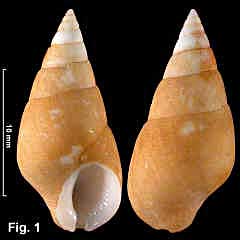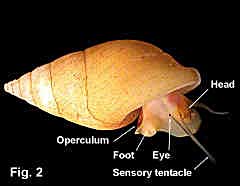|
|
|
|
|
Hinea brasiliana (Lamarck, 1822) Description: Shell solid and heavy. Whorls slightly convex, smooth or with very weak spiral grooves. Base with several stronger spiral grooves. Aperture narrow, constricted by callus; columella heavily calloused. Outer lip thin at edge, greatly thickened internally, with weak lirae on thickening. Anterior canal wide, posterior canal narrow. Colour white internally and externally, with thick yellowish brown periostracum, partly eroded from spire in live shells and rapidly lost in dead shells. Operculum corneous. Size: Up to 21.5 mm in length. Distribution: In Australia, from Burnett River, Queensland, southwards to Mt. Gambier, SA. Also Lord Howe Is., Norfolk Is., Kermadec Islands and northern New Zealand. Habitat: "The species is gregarious and occurs in discrete populations among rocks and rubble in the midlittoral zone along exposed rocky, high energy coastlines. Populations usually live in somewhat protected areas not in direct contact with large waves. Individuals are found in clusters under rocks, in moist, dark places during low tide, but become very active and rapidly disperse when submerged by incoming tides" (Houbrick, 1987). Common. Remarks: This animal is one of the few marine gastropods that exhibit bioluminescence. Ponder (1988) found that specimens kept in a container in a dark room emitted a bright blue-white light for up to a minute when disturbed. The species is discussed in detail by Houbrick (1987). Fig. 1: South of Easts Beach, Kiama, NSW (DLB5152) Fig. 2: Barrenjoey, Pittwater, NSW (DLB5093) |

